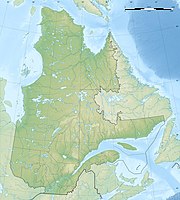Réserve écologique de la Vallée-du-Ruiter
|
Réserve écologique de la Vallée-du-Ruiter
|
||
| location | Memphrémagog , Québec, Canada | |
| surface | 1.17 km² | |
| WDPA ID | 66623 | |
| Geographical location | 45 ° 6 ' N , 72 ° 26' W | |
|
|
||
| Setup date | 1993 | |
| administration | MDDEP | |
The Réserve écologique de la Vallée-du-Ruiter is an ecological reserve in the extreme south of the Canadian province of Québec .
It was established in 1993 on an area of 117 ha. It is located in the regional county town of Memphrémagog , 12 km west of Lac Memphrémagog , 4 km northwest of Potton . It lies between two bodies of water, the Rivière Missisquoi and the Ruisseau Ruiter , in the Sutton Mountains.
The area protects sugar maple forest in conjunction with linden and yellow birch in the Sherbrooke ecoregion. The Sutton Mountains run from southwest to northeast, with the terrain rising from the Ruiter Valley at a height of 300 m above sea level to 550 m . Slate-like rock structures, mica , here called mica , characterize the subsoil. During the last Ice Age, Tillit was deposited here , the strength of which is largely determined by the steepness of the slopes. Here prevail Podsol before and brown earth.
In addition to the main species of the ecoregion, the American beech , groups of white birch and butternut , Virginian hop beech ( Ostrya virginiana ), white ash , linden and red ash ( Fraxinus pennsylvanica ) are often found . The following are considered endangered or threatened: Allium tricoccum , the fern Athyrium pycnocarpon from the family of Athyriaceae , Carex prasina and Carex appalachica from the genus of sedges ( Carex ), Panicum clandestinum from the genus of millet , and Viola rotundifolia from the genus of violets .
21 species of birds live in the reserve, including the Barred Owl ( Strix varia , French .: chouette rayée), the Pileated Woodpecker , the largest woodpecker in America, the Cedar Waxwing ( Bombycilla cedrorum , French .: jaseur of cèdres or d'Amérique), the Sockeye Warbler , which is called Paruline bleue à gorge noire in Québec, followed by the woodpecker called Pic maculé, yellow-bellied juice lickers, and the roach vireo ( Vireo olivaceus ).
The number of mammals recorded is rather small. These include the white-tailed deer and Tamias striatus from the kind of chipmunks . Moose, black bears and raccoons have also been observed.
About 20 species of insects have been recorded, including the Actias luna butterfly , which is endangered in Québec. Amphibians and reptiles have also been observed, such as the common garter snake , the wood frog , the toad species Anaxyrus americanus or Gyrinophilus porphyriticus , which is called Salamandre pourpre here.
In 2007, the Fondation de la faune du Québec, in collaboration with the University of Montreal, found that the puma (cougar or Puma concolor ), which had been exterminated since 1938, was again in Québec. At least eight specimens were found in the Saguenay – Lac-Saint-Jean , in the Réserve faunique des Laurentides , in Abitibi-Témiscamingue , in East-Hereford (Estrie) , in the Forillon National Park and in the Parc national de la Gaspésie as well as here discussed protected area in the Ruitertal. It was still unclear whether they were descendants of the population native to the east or whether they were immigrants from the west or south.
Web links
- Réserve écologique de la Vallée-du-Ruiter , government website
Remarks
- ↑ Les Parulines Nord-Américaines ( page no longer available , search in web archives ) Info: The link was automatically marked as defective. Please check the link according to the instructions and then remove this notice.
- ↑ Le cougar de l'est est présent au Québec (PDF, 38.3 kB).




